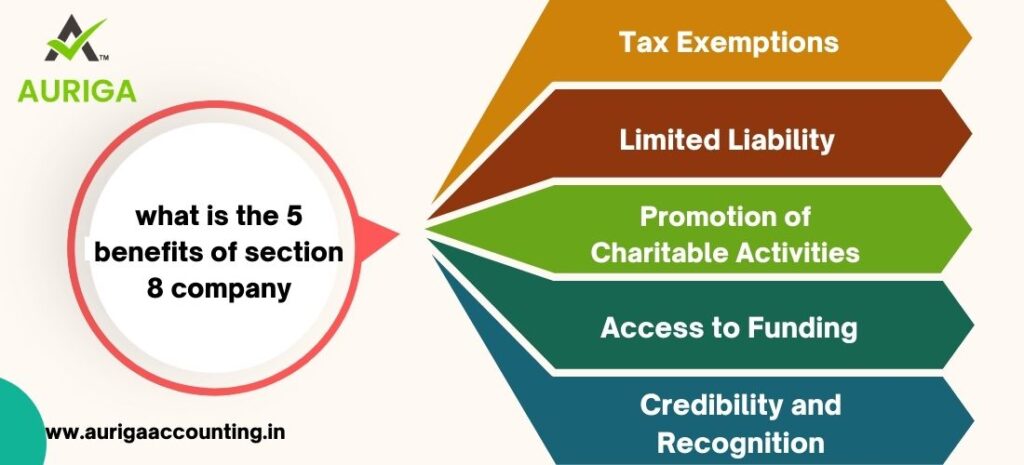
HOW IS A SECTION 8 COMPANY DIFFERENT FROM A REGULAR COMPANY?
Introduction
ToggleYOU NEED TO KNOW HOW IS A SECTION 8 COMPANY DIFFERENT FROM A REGULAR COMPANY?
A Section 8 Company, under Section 8 of the Companies Act, 2013, is formed for non-profit purposes, promoting charitable activities. It cannot distribute profits among members and must reinvest in its objectives. In contrast, a regular for-profit company is established to generate profits for its shareholders, allowing dividend distribution. The registration process, compliance requirements, and tax implications differ, with Section 8 companies potentially enjoying tax exemptions. While both entities have ownership structures, Section 8 companies prioritize social impact, utilizing funds for community welfare, whereas regular companies aim at maximizing shareholder value. Understanding these distinctions is essential for selecting the appropriate organizational structure. Visitofficialwebsite
DIFFRENT BETWEEN SECTION 8 COMPANY AND REGULAR COMPANY
Profit Objective:
Section 8 Company: The primary objective of a Section 8 Company is to promote charitable, non-profit, and socially beneficial activities. These organizations are not formed for making profits. Any income generated by a Section 8 Company is used solely for the furtherance of its objectives, and no dividends or profits are distributed to its members.
Regular Company: A regular company, also known as a for-profit company, is established with the primary goal of generating profits for its shareholders or owners. These companies can distribute profits among their shareholders in the form of dividends.
Use of Profits:
Section 8 Company: Any income or surplus generated by a Section 8 Company must be applied exclusively for the promotion of its charitable or non-profit objects. The profits cannot be distributed to members, and they must be reinvested in the organization’s activities.
Regular Company: Profits earned by a regular company can be distributed to shareholders in the form of dividends, used for expansion, reinvested in the business, or employed in any other manner the company’s management deems fit.
Limited Liability:
Section 8 Company: Members of a Section 8 Company have limited liability. Their personal assets are safeguarded in case of financial troubles, and they are not personally liable for the company’s debts and obligations.
Regular Company: In a regular company, the extent of liability varies depending on the structure of the company. In a public limited company, shareholders generally have limited liability, but in private limited companies or partnerships, personal assets can be at risk.
Legal Structure and Compliance:
Section 8 Company: These companies are registered under Section 8 of the Companies Act, 2013, which is specifically designed for non-profit organizations. They must adhere to the rules and regulations governing their operations, including restrictions on profit distribution.
Regular Company: Regular companies are governed by various sections of the Companies Act, depending on their structure (e.g., private limited, public limited, one-person company). Their primary focus is on conducting business operations for profit.
Tax Benefits:
Section 8 Company: Section 8 Companies are eligible for various tax benefits, including exemptions and deductions under the Income Tax Act, 1961. Donations to Section 8 Companies may be eligible for tax deductions, encouraging contributions.
Regular Company: Regular companies are subject to corporate income tax, and dividends received by shareholders are also taxed. There are no specific tax benefits associated with regular companies for charitable activities.
Objective and Activities:
Section 8 Company: The primary objective is to advance charitable, educational, cultural, religious, social, and environmental activities. Section 8 Companies are typically involved in non-profit work, such as education, healthcare, relief of poverty, and cultural preservation.
Regular Company: The primary objective of a regular company is to generate profits for its owners or shareholders. Their activities may include manufacturing, trading, providing services, or any other business operations.
Ownership and Governance:
Section 8 Company: These companies may have members or subscribers, but they do not have shareholders. The governance structure is typically managed by a board of directors or a governing body. Ownership is not based on shareholding.
Regular Company: Regular companies are owned by shareholders who hold shares and have voting rights in the company. Governance is often based on the shareholding structure, and the management is accountable to the shareholders.
Compliance and Reporting:
Section 8 Company: Section 8 Companies are subject to specific compliance requirements, including annual compliance reporting with the Registrar of Companies (ROC) and adherence to the objectives stated in their memorandum and articles of association.
Regular Company: Regular companies must comply with the general provisions of the Companies Act, which includes financial reporting, annual general meetings, and various other statutory requirements.
Legacy and Sustainability:
Section 8 Company: Section 8 Companies often have a strong focus on legacy and long-term sustainability, planning for the continuation of their charitable activities beyond the tenure of their founding members.
Regular Company: The focus of regular companies is typically on short- to medium-term profitability and growth.
What is the difference between Section 8 company and Section 25 company
The terms “Section 8 company” and “Section 25 company” refer to the same legal concept, but they represent different sections of the Companies Act. The Companies Act of 1956 initially contained Section 25, which governed companies formed for charitable or non-profit purposes. The Companies Act of 2013 replaced the earlier legislation but retained the provisions related to non-profit companies under Section 8. Therefore, the key difference lies in the section number and the legislative framework. Here’s a breakdown:
Section 8 Company:
- Legislation: The term “Section 8 company” is used in reference to companies incorporated under Section 8 of the Companies Act, 2013.
- Objective: Section 8 companies are formed with the primary purpose of promoting charitable or non-profit activities, such as education, art, science, sports, social welfare, religion, and more.
- Profit Utilization: Profits generated by Section 8 companies cannot be distributed among members but must be used for furthering the company’s objectives.
2. Section 25 Company:
- Legislation: The term “Section 25 company” refers to companies incorporated under Section 25 of the Companies Act, 1956.
- Objective: Like Section 8 companies, Section 25 companies were formed for promoting charitable or non-profit objectives. These objectives were similar to those listed in Section 8 of the Companies Act, 2013.
- Profit Utilization: Similar to Section 8 companies, Section 25 companies were not allowed to distribute profits among members and were required to utilize any surplus for their objectives.
In essence, both Section 8 companies and Section 25 companies served the same purpose but were governed by different sections of the Companies Act due to changes in legislation over time. The transition from Section 25 to Section 8 occurred with the enactment of the Companies Act, 2013. Therefore, the term “Section 8 company” is the more current and relevant term. Companies that were registered under Section 25 of the 1956 Act continue to operate as Section 8 companies under the Companies Act, 2013.
What is the purpose of a Section 8 company
The purpose of a Section 8 company, as defined by the Companies Act, 2013 in India, is to promote charitable or non-profit objectives. These companies are formed with the primary aim of utilizing their resources and income for activities that benefit the public or a specific group of people. The key purposes of a Section 8 company include:
Promotion of Charitable Activities: Section 8 companies are established to promote activities such as education, art, science, sports, social welfare, religion, and other similar objectives that are for the benefit of the community or the public at large.
Non-Profit Nature: The fundamental characteristic of Section 8 companies is their non-profit nature. Unlike for-profit companies, Section 8 companies are not formed for the purpose of making profits for their members. Any income generated must be used to advance the company’s objectives rather than being distributed as dividends.
Social Welfare and Development: Section 8 companies often engage in social welfare and developmental activities. They may work towards the betterment of society, poverty alleviation, healthcare, environmental conservation, and other causes that contribute to the overall well-being of the community.
Educational and Cultural Advancement: Many Section 8 companies focus on educational and cultural activities. They may establish schools, colleges, libraries, cultural centers, and other institutions to promote learning, arts, and culture.
Religious or Spiritual Objectives: Some Section 8 companies may be formed for religious or spiritual purposes, supporting the practice and propagation of specific beliefs and traditions.
Utilization of Surplus for Objectives: Any surplus funds or income generated by a Section 8 company must be reinvested in the organization to further its charitable objectives. The funds cannot be distributed among the members.
Legal Framework for Non-Profit Entities: The formation of Section 8 companies is governed by specific legal provisions to ensure transparency, accountability, and compliance with the intended non-profit nature of their activities.
Overall, the purpose of a Section 8 company is to create a legal structure that allows individuals with a common goal of promoting charitable or non-profit activities to pool their resources and work collectively for the greater good of society.

what is the 5 benefits of section 8 company
Section 8 companies, also known as non-profit organizations or non-governmental organizations (NGOs), are formed under Section 8 of the Companies Act, 2013 in India. These companies operate with the primary objective of promoting charitable activities for the public good. Here are five benefits of Section 8 companies:
Promotion of Charitable Activities: The primary benefit of a Section 8 company is its ability to engage in activities that promote the social welfare, such as education, healthcare, poverty alleviation, environmental sustainability, and more. These companies are dedicated to working for the benefit of the community and society at large.
Tax Exemptions: Section 8 companies enjoy certain tax benefits. They may be eligible for income tax exemptions under Section 12A and 80G of the Income Tax Act, making donations to these organizations attractive for individuals and businesses looking to contribute to social causes.
Limited Liability: Like any other company registered under the Companies Act, a Section 8 company operates as a legal entity with limited liability. This means that the personal assets of the members or shareholders are not at risk in case of financial liabilities incurred by the company.
Access to Funding: Section 8 companies can raise funds through donations, grants, and other sources to support their charitable activities. Additionally, they can apply for government grants, corporate funding, and international aid, which is often more accessible to registered non-profit entities.
Credibility and Recognition: Being registered as a Section 8 company lends credibility to the organization. It is often seen as a mark of dedication to social causes, which can help in gaining the trust of donors, volunteers, and the general public. Such recognition can enhance the organization’s ability to attract resources and support.
It’s important to note that while Section 8 companies enjoy various benefits, they are also subject to regulatory compliance and must operate within the framework defined by the Companies Act. Additionally, the specific benefits may vary based on the nature of activities, compliance with regulations, and the organization’s adherence to its charitable objectives.
How many directors can a Section 8 company have
As per the Companies Act, 2013, which governs the functioning of companies in India, there are specific requirements regarding the number of directors in a Section 8 company. Here are the key points:
Minimum Directors: A Section 8 company must have a minimum of two directors.
Maximum Directors: There is no specific maximum limit on the number of directors a Section 8 company can have. However, the company’s Articles of Association may prescribe a maximum limit, if any. If there is no such limit specified in the Articles, the company can appoint directors within the framework of the Act.
Board Composition: The composition of the board of directors is crucial for the effective governance of the company. While there is no maximum limit prescribed by law, the number of directors should be practical for decision-making and the smooth functioning of the organization.
Appointment and Rotation: Directors in a Section 8 company are appointed by the members (shareholders) of the company. The Articles of Association may also outline the process for the appointment and rotation of directors.
It’s essential for Section 8 companies to comply with the legal requirements related to the composition of the board of directors, as outlined in the Companies Act, 2013, and any other relevant regulations. The board plays a crucial role in overseeing the company’s activities and ensuring that it adheres to its non-profit objectives. Companies should also consider best practices in corporate governance when determining the size and composition of their boards.
CONCLUSION OF SECTION 8 COMPANY AND REGULAR COMPANY
In conclusion, Section 8 Companies and Regular Companies represent two distinct categories of legal entities with fundamentally different objectives, structures, and purposes. The primary contrast between these entities lies in their core mission: Section 8 Companies are established for non-profit and charitable activities, while Regular Companies are primarily profit-driven. Here’s a summary of the key distinctions:
Section 8 Company:
Non-Profit and Charitable Focus: The core mission of a Section 8 Company is to advance charitable, educational, cultural, religious, social, and environmental activities. These organizations are explicitly established for non-profit purposes and must utilize any income or surplus solely for their defined charitable objectives.
Limited Liability: Members of a Section 8 Company have limited liability, ensuring the protection of their personal assets in case of financial difficulties. They are not personally liable for the company’s debts.
Legal Structure: Section 8 Companies are registered under Section 8 of the Companies Act, 2013, which is specifically designed for non-profit organizations. They are subject to rules and regulations governing their operations, with restrictions on profit distribution.
Tax Benefits: Section 8 Companies enjoy tax benefits, including exemptions and deductions under the Income Tax Act, 1961. Donations to these organizations are eligible for tax deductions, incentivizing contributions.
Objective and Activities: Their primary objective is to serve the public good and address a wide range of societal needs. They engage in non-profit work, such as education, healthcare, poverty relief, cultural preservation, and more.
Ownership and Governance: Section 8 Companies may have members or subscribers, but they do not have shareholders. Governance is typically overseen by a board of directors or governing body, with ownership not based on shareholding.
Compliance and Reporting: They must adhere to specific compliance requirements, including annual reporting with the Registrar of Companies (ROC) and the fulfillment of their defined charitable objectives.
Legacy and Sustainability: Section 8 Companies often emphasize long-term legacy planning and sustainability, ensuring the continuity of their charitable activities well beyond their founding members’ tenure.
Regular Company:
Profit-Driven: Regular Companies are primarily profit-driven entities, established to generate profits for their owners or shareholders. They engage in business operations aimed at maximizing profitability.
Variable Liability: The extent of liability varies depending on the company’s structure, with shareholders in public limited companies enjoying limited liability. In private limited companies or partnerships, personal assets can be at risk.
Legal Structure: Regular companies are governed by various sections of the Companies Act, with a primary focus on business operations, profitability, and growth.
Taxation: Regular companies are subject to corporate income tax, and dividends received by shareholders are also taxed. There are no specific tax benefits associated with regular companies for charitable activities.
Objective and Activities: Their primary objective is to maximize profitability through various business activities, including manufacturing, trading, services, and more.
Ownership and Governance: Regular companies are owned by shareholders who hold shares and have voting rights. Governance is typically based on the shareholding structure, with management accountable to shareholders.
Compliance and Reporting: Regular companies must comply with general provisions of the Companies Act, including financial reporting, annual general meetings, and various statutory requirements.
Short-to-Medium-Term Focus: Regular companies primarily focus on short- to medium-term profitability and growth, with an emphasis on generating financial returns for shareholders.
HOW AURIGA ACCOUNTING DEFINE DIFFERENT BETWEEN SECTION 8 COMPANY AND REGULAR COMPANY
Mission and Objectives:
Section 8 Company: Auriga Accounting can emphasize that Section 8 Companies are primarily established to promote charitable, non-profit, and socially beneficial activities. Their mission is centered around advancing specific objectives, such as education, healthcare, or cultural preservation, with the goal of benefiting society and the public at large.
Regular Company: For Regular Companies, Auriga Accounting can clarify that the primary objective is profit generation. They are formed to engage in various business activities to maximize profitability for the benefit of their owners or shareholders.
Profit Distribution:
Section 8 Company: Auriga Accounting can explain that Section 8 Companies are not allowed to distribute profits to their members or stakeholders. Any income generated must be reinvested in furthering their charitable objectives, ensuring that profits are plowed back into the organization.
Regular Company: In contrast, Auriga Accounting can highlight that Regular Companies can distribute profits among their shareholders in the form of dividends. These companies exist to generate profits for their owners.
Legal Structure and Compliance:
Section 8 Company: Auriga Accounting can clarify that Section 8 Companies are registered under Section 8 of the Companies Act, 2013, and are subject to specific rules and regulations governing their operations. Compliance includes adhering to the charitable objectives and reporting to the Registrar of Companies (ROC).
Regular Company: Regular Companies are subject to general provisions of the Companies Act based on their specific structure, such as private limited, public limited, or one-person company. Their compliance requirements relate to business operations and corporate governance.
Tax Benefits:
Section 8 Company: Auriga Accounting can highlight that Section 8 Companies are eligible for various tax benefits, including exemptions and deductions under the Income Tax Act, 1961. Donations to Section 8 Companies may also be eligible for tax deductions, making them attractive for contributors.
Regular Company: For Regular Companies, Auriga Accounting can clarify that they are subject to corporate income tax, and dividends received by shareholders are also taxed. They do not receive specific tax benefits related to non-profit activities.
Ownership and Governance:
Section 8 Company: Auriga Accounting can explain that Section 8 Companies may have members or subscribers, but they do not have shareholders in the traditional sense. Governance is typically overseen by a board of directors or governing body, with ownership not based on shareholding.
Regular Company: In contrast, Auriga Accounting can emphasize that Regular Companies are owned by shareholders who hold shares and have voting rights in the company. Governance is often based on the shareholding structure, and the management is accountable to the shareholders.












